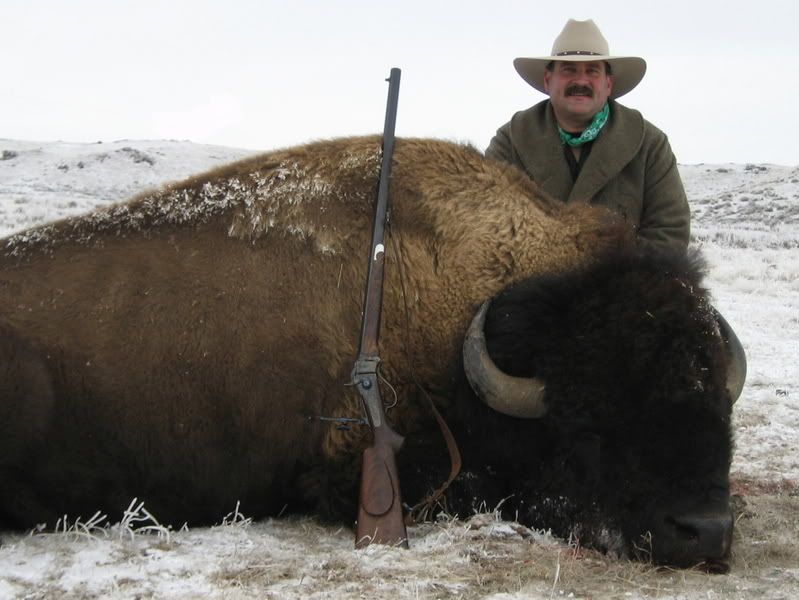We arrived in Gillette on Feb. 8th, and hunted Feb. 9, 10, and 11. It was agreed that I would go first since I wanted a good “haired up” bull for a full shoulder mount, and the others were only going to have skull mounts done. I was shooting my Shiloh Sharps number 1, caliber 50 2 ½”. I had loaded my cartridges with a pure lead tapered paper patch flat nose bullet from Buffalo Arms, over 95 grains of Swiss 1 ½ with a 1/8” SPG lube cookie and .06” over powder and over lube wads, sparked by CCI BR-2 primers. This load gave me over 1300 fps with 1 ½” and 2 ½” groups at 100 and 150 yards, respectively. I know that isn’t match grade accuracy, but I figured it would be “minute of buffalo.” 610 grain grease groove bullets from Montana Bullet Works will shoot more accurately out of this rifle, but I wanted to use lead paper patch bullets for hunting purposes.
The morning of the 9th was partly cloudy and about 18 degrees, with about 3-4” of fresh snow on the ground. After about an hour of glassing from various vantage points, we located 3 bulls that were in position for a stalk. One in particular had the type of hide I was looking for, as well as good horn length. One thing I quickly learned is that field judging for score on these bulls is tough. Horn length can be judged to a point, but the base of the horns on all the bulls I saw were covered by hair, making it impossible to judge the base of the horns for mass. Since the bull carried decent mass along the length of the horns, I hoped the base would also have good mass. But again, the hide was very long and full, which was my first priority.
After some maneuvering to get a ridge between us, and a pretty easy ½ mile walk on the backside of a ridge, I was able to edge up over the ridge in the rocks and come out above the bulls. I would be shooting downhill at about a 45-degree angle; the distance as they fed left to right was about 110 yards. Setting my shooting sticks aside, I set up in the rocks and waited for a broadside shot.
When the bull I had chosen turned broadside to me as he fed, I aimed about one third of the way up on the bull, just behind and tight against the front shoulder. At the shot, my bull trotted in a circle about 15 yards away, and then went down. My slug had taken the aorta at the top of the heart and also nicked the bottom of a lung, causing massive bleeding resulting in a quick, clean kill. The slug lost no weight, and was found under the offside hide expanded to .65”. The slug hit no bone, entering and exiting the body cavity between ribs. I thought the pure lead bullet would have expanded more, but it did the job nevertheless. The bull green scored 68 SCI points, above the minimum score of 54 needed to make the “book.” With over 950 pounds of hanging meat, Marion estimated the live weight of the bull at 1900 pounds. Marion believes about 50% of the bulls weight is carried in the head, hide, entrails, etc., and I believe it.
As many of you have already stated, these are big, tough animals and shot placement (just like anything else) is very important. Marion related horror stories of former clients shooting bulls with everything from archery equipment to 416 Remington magnums, and if the bull is poorly hit it will soak up a lot of lead and run a long way. Marion and his clients have taken over 150 bulls, so he has seen a lot of bulls hit and the damage certain projectiles cause. Marion says that he is getting more and more impressed with the killing ability of what he calls “Those old time guns.” Marion believes the large caliber; slow moving bullets that are normally chambered in BPCR rifles are good killers. Marion likes soft lead bullets rather than bullets cast of a hardened mixture, so the bullet will upset in the animal and cause more damage, rather than sailing through with minimal expansion. His rational is this: Bison are large heavy animals, but in the area where we would want to put a broadside shot in the vitals, they are not that thick. The hide itself is very thick and tough, but if the bullet stops under the offside hide, it has already penetrated the vital area of the bull causing injuries that will result in the bull’s death.
I would add to this that I believe in flat nose bullets for low velocity cartridge hunting. I have seen hundreds of bullet wounds in animals and humans, and know that low velocity bullets will not always expand. A round nose bullet will stretch the skin (hide) and most tissue to a breaking point, and then pass through, causing the tissue to spring back into its original position, leaving a smaller than caliber hole in the tissue. (This excludes those organs with non-stretchable tissue.) This type of wound is seen most often in low velocity rounds, like handgun rounds and most BPCR rifles. A semi-wadcutter with a defined edge, or to a lesser extent a flat nose bullet, will cut a hole in the skin, hide, and tissue, that is full caliber or close to it, leaving a bigger hole from crush damage after the stretching takes place. Bigger holes mean more tissue damage at these low velocities.
I have included pictures of my bull and pictures of the unfired and expanded round from my rifle. I will include details of Max’s and Steve’s hunts on other posts.


